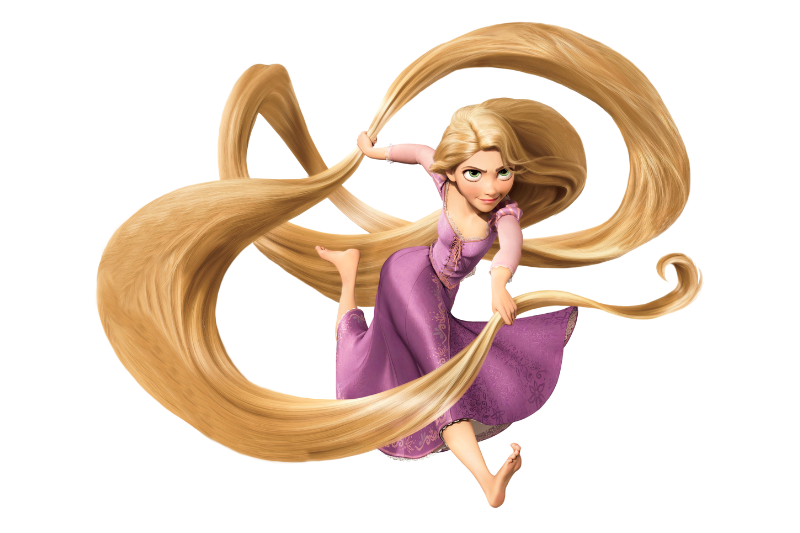
Laura TURCULET
In Disney’s adaptation of Grimm’s fairy tale, Tangled, Rapunzel is imprisoned at the top of a tower. Flynn Rider, the famous thief on the run, comes to save her: ‘Rapunzel, Rapunzel, let down your hair’, he says. She then lets her golden locks down out of the window, and her savior climbs up her enchanted hair, using it like a rope. That Disney movie may seem a bit far-fetched. Is human hair strong enough to lift another human?
How Strong Can Hair Be?

Hair is strong. Very strong. One single strand of hair can take a force of 200 megapascals. That is called ‘tensile strength’. It defines how much load a strand of hair can take when it is being pulled on. We measure pressure in pascals. One pascal determines the load a material can take per square meter. One megapascal corresponds to 1 million pascals. If we talk about human hair, 200 megapascals are 20 million kilograms (around 44 million lbs) of force per square meter of human hair.
Wow, that seems like a lot, doesn’t it? So, Ray Goldstein, from the University of Cambridge, England, explains that one single strand of hair is half as strong as a steel stem of the same size. But how come hair is so exceptionally strong?


Keratin, the Protein That Makes You Tear Your Hair Out
Wen Yang is a researcher in the field of materials at the University of California, United States. She suggests that hair’s structure is responsible for its stiff resistance. She compares hair to a Russian doll. The biggest one, representing the strand of hair, encases millions of other smaller dolls. These dolls stand for tiny protein chains and are found in the cortex. The cortex is covered by the cuticle, an external layer that covers the chains.
Keratin is a protein that makes up your hair, nails, but also animal horns, hooves, or feathers. This protein is rich in sulphur and plays a role in cell proliferation and in the transportation of substances in the body. It is found in many beauty products, such as shampoos and conditioners. These hair products aim to strengthen the hair fiber and the scales.
Not only are the princess’s locks strong but also very long. However, that considerable length might weaken her hair, notes Rhett Allain from the Southeastern Louisiana University, United States. Keratin chains are small atoms connected by springs. If you pull too much on your hair, the springs might break. No chain is unbreakable. In fact, the longer the chain, the more chances of breakage there are. Rapunzel’s solution is to let down a long braid or ponytail, instead of one single strand of hair.
On its own, the keratin chain may be weak, but put together, they are exceptionally strong.


Could Human Hair Replace a Ladder?
Yang and Goldstein say that 500 to 1,000 hairs could indeed lift an adult weighing 80 kilograms (176,37 lbs). That’s not much compared to the amount of hair on your head. Your head actually has between 50,000 and 100,000 hairs, Goldstein added.
However, if you were to take Rapunzel’s example, the beauty of your mane would hang by a thread. Your hair holds onto your scalp thanks to follicles, which are biological structures. They are not as strong as hair. You may have already noticed that pulling too hard on your hair may cause it to come off. Therefore, although hair can support the weight, your scalp cannot. If Flynn wants to reunite with his beloved one, Rapunzel must loop her hair around a pole or a hook. That would create a pulley to avoid breakage.

A pulley
A wheel that can turn on an axle by means of a chain or cable that is used to lift a heavy weight.

The Use of Hair in Daily Life

Hair is strong and supple. It would definitely do a good job as a ladder. So why don’t we use hair like that? Yang says that people did use human hair for some things in the past. It was useful in surgery to sew skin closed. But since it is a natural material, in our environment, hair breaks easily. What are more, temperature and air humidity can damage keratin. Synthetic materials are, therefore, more resilient.
In addition, Goldstein says that hair is quite slick. It is not very subject to friction. Friction is when your hair rubs against another surface. Even if you manage to twist it into a rope, hair would be too slippery and would be less efficient. You’d better use a regular rope.
There’s also the cultural aspect. Wouldn’t you find it odd to use your buddies’ hair to climb a wall?
To conclude, hair grows way too slowly to be used as a tool. It grows about 15 centimeters (6 inches) a year. At that rate, if Rapunzel were trapped at the top of a 10-meter-tall (32.8 feet) tower, it would take 66.6 years for her hair to reach the ground. That’s a long wait for rescue.
In brief, although hair is scientifically proven resilient, don’t let anyone get in your hair!




